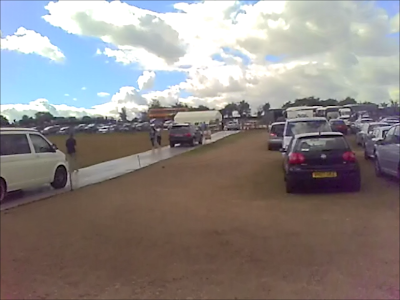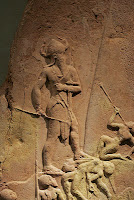Stonehenge.
"An Immediate and Sensory Link to the Past"
A couple of weeks ago I went to document the late 1960's iteration of Stonehenge and to asses the new.
Reader, forgive me, but I refuse to see Stonehenge as a 'Prehistoric' monument.
The car park is still in the same place, just all parking is on what was once the overflow car park.
There is a parking charge
I guess it to be either £3 or £5.
I don't know because I have NT membership...
The road beyond the entrance to the car park to the junction with the A 303 (the red X) is gone.
There used to be a perilous turn off the A 303 which took the traveler past the stones on the A344, and another right turn soon after, into the car-park.
You can't do that any more...
Now the traveler stays on the A 303, passing Stonehenge.
There are signposts telling you where to go.
It is always busy.
Stonehenge.
So many people!
Early 1960s Visitor numbers between 300,000 and 400,000 per year.
1977 Visitor numbers reach 800,000.
1982 Visitor figures down to 500,000.
1983 Visitor figures begin to rise again, reaching 600,000.
1,023,000 visitors to Stonehenge in 2010/11 (excluding the Solstice and including free education visits and stone circle access).
Next photo is the entrance queue.
We were here pretty early!
Back to the entrance,
The buildings: pay-booths, shops, toilets were built some time in the 1960s.
Flat roofed, metal and concrete.
Utilitarian
Britain post war trying to be 'modern' and yet there is still something post-war, 1950s pre-fab about the design.
After the queue
The 'time tunnel'
Entrance to the field containing Stonehenge is through another favorite structure of the 1960s, the underpass.
The walls of the underpass are painted to give you the impression- it fails- that you are walking into the Late Neolithic.
Somewhere between queuing, paying and walking through the turnstiles, time one is supposed to intuit, has spun backwards.
You are now moving rapidly through the centuries...
And find yourself looking at an illustration of how the stones were transported from Fyfield.
Men wore biblical dress
Or
Towels.
Hair was a safe 1960s length
Not short like a conscript.
Not too long like a 'bloody hippy'.
Hauling stones was man's work!
After zig-zaging through the underpass this is your first view of Stonehenge.
Looking back to the underpass.
Now, when you paid you were offered an audio guide.
I have always avoided this because well...I know it all anyway (!)
Worse, it makes everyone look as if they are listening intently to a troubled friend on their phone.
I picked up an audio guide.
The audio guide directs one to stand close to a small metal plaque with a number on it.
Only 'one' is not one.
One is one of 1,023,000/365 = 2842 people a day...
2842/10 (hours of opening) = 284 people...
Actually, that doesn't seem so many..
No matter!
They were all there when I was.
Bottlenecks occur around the numbers.
People wonder around, distracted...
I was one of them.
Which brings me to the final part.
The A 303 isn't so far away from the SSE border of Stonehenge.
But it used to be that you could stand pretty close to the Heel stone, just behind the fence and look towards Stonehenge.
The Heel stone is NE from the center of the circle and the traditional entrance (or exit) leading towards the river.
Well now, you are never going to get that close to Stonehenge again, unless you pay.
There was some talk of putting the A 303 underground.
How far is the new perimeter going to be...
Have I missed my chance to walk the cursus when ever I feel brave enough (cows and military land = fear!)
I resent the land being owned and partitioned.
Stonehenge around the solstices is a brutal experience anyway...police and traffic queues..
Keep well away
Unless you are into modern tourist rituals.
Fortunately there is more to Wessex than Stonehenge.
Knap hill for instance.
A couple of weeks ago I went to document the late 1960's iteration of Stonehenge and to asses the new.
Reader, forgive me, but I refuse to see Stonehenge as a 'Prehistoric' monument.
The car park is still in the same place, just all parking is on what was once the overflow car park.
There is a parking charge
I guess it to be either £3 or £5.
I don't know because I have NT membership...
 |
| Looking towards the closed road and the stones. |
 |
| Looking at the closed A344. |
There used to be a perilous turn off the A 303 which took the traveler past the stones on the A344, and another right turn soon after, into the car-park.
You can't do that any more...
Now the traveler stays on the A 303, passing Stonehenge.
There are signposts telling you where to go.
It is always busy.
Stonehenge.
So many people!
Early 1960s Visitor numbers between 300,000 and 400,000 per year.
1977 Visitor numbers reach 800,000.
1982 Visitor figures down to 500,000.
1983 Visitor figures begin to rise again, reaching 600,000.
1,023,000 visitors to Stonehenge in 2010/11 (excluding the Solstice and including free education visits and stone circle access).
Next photo is the entrance queue.
We were here pretty early!
 |
| Looking back towards the car park, towards the cursus. |
 |
| Stones behind me, looking towards the closed road (A344). |
The buildings: pay-booths, shops, toilets were built some time in the 1960s.
Flat roofed, metal and concrete.
Utilitarian
Britain post war trying to be 'modern' and yet there is still something post-war, 1950s pre-fab about the design.
After the queue
The 'time tunnel'
Entrance to the field containing Stonehenge is through another favorite structure of the 1960s, the underpass.
The walls of the underpass are painted to give you the impression- it fails- that you are walking into the Late Neolithic.
Somewhere between queuing, paying and walking through the turnstiles, time one is supposed to intuit, has spun backwards.
You are now moving rapidly through the centuries...
 |
| The 'Mesolithic'. |
Men wore biblical dress
Or
Towels.
Hair was a safe 1960s length
Not short like a conscript.
Not too long like a 'bloody hippy'.
Hauling stones was man's work!
After zig-zaging through the underpass this is your first view of Stonehenge.
 |
| Almost at the time tunnel exit. |
Now, when you paid you were offered an audio guide.
I have always avoided this because well...I know it all anyway (!)
Worse, it makes everyone look as if they are listening intently to a troubled friend on their phone.
I picked up an audio guide.
The audio guide directs one to stand close to a small metal plaque with a number on it.
Only 'one' is not one.
One is one of 1,023,000/365 = 2842 people a day...
2842/10 (hours of opening) = 284 people...
Actually, that doesn't seem so many..
No matter!
They were all there when I was.
Bottlenecks occur around the numbers.
People wonder around, distracted...
I was one of them.
Which brings me to the final part.
The A 303 isn't so far away from the SSE border of Stonehenge.
 |
| A 303. |
But it used to be that you could stand pretty close to the Heel stone, just behind the fence and look towards Stonehenge.
 |
| The Heel stone. |
The Heel stone is NE from the center of the circle and the traditional entrance (or exit) leading towards the river.
Well now, you are never going to get that close to Stonehenge again, unless you pay.
There was some talk of putting the A 303 underground.
"Our vision is a 6,000-acre prehistoric natural wilderness containing over 450 ancient monuments, as well as Stonehenge itself. To achieve this, we would close the A344 and return it to grassland. The A303 would be sent through an underground tunnel where it passes the site. We would remove the existing (and woefully inadequate) visitors centre and car park and build a new Visitor Complex at least a kilometre away from the Stones. By making Stonehenge harder to get to, we would make it more accessible. Visitors would be able to roam freely (and free of charge) among the monuments, unfettered by fences. [LINK]Though that sounds good- ignoring the paradoxical ' By making Stonehenge harder to get to, we would make it more accessible'- I can't imagine there ever being a time when, "visitors would be able to roam freely (and free of charge) among the monuments, unfettered by fences".
How far is the new perimeter going to be...
Have I missed my chance to walk the cursus when ever I feel brave enough (cows and military land = fear!)
I resent the land being owned and partitioned.
Stonehenge around the solstices is a brutal experience anyway...police and traffic queues..
Keep well away
Unless you are into modern tourist rituals.
Fortunately there is more to Wessex than Stonehenge.
Knap hill for instance.











